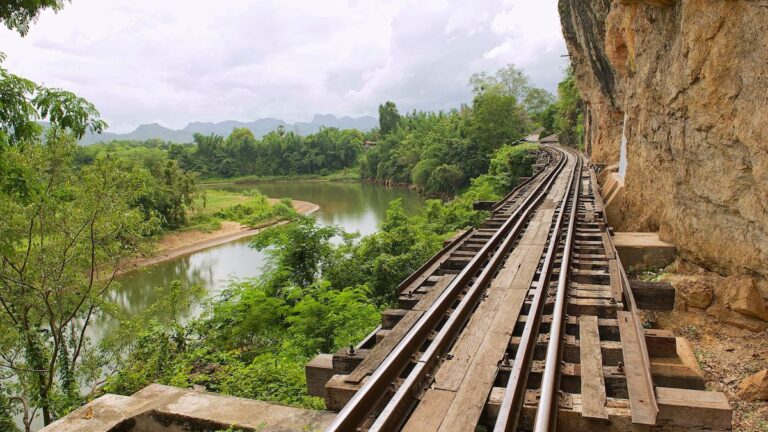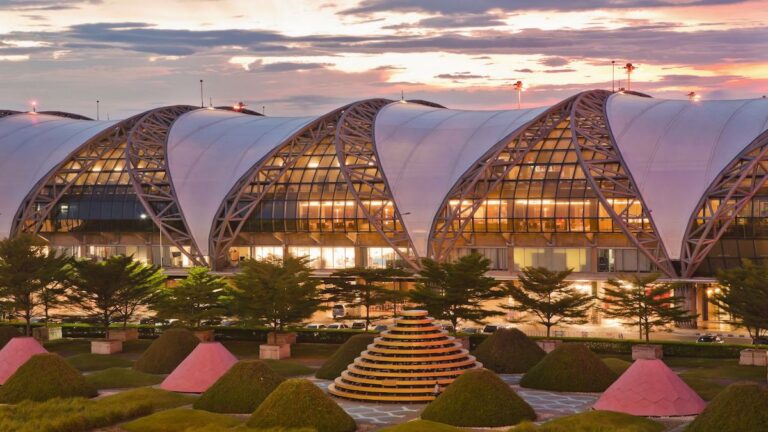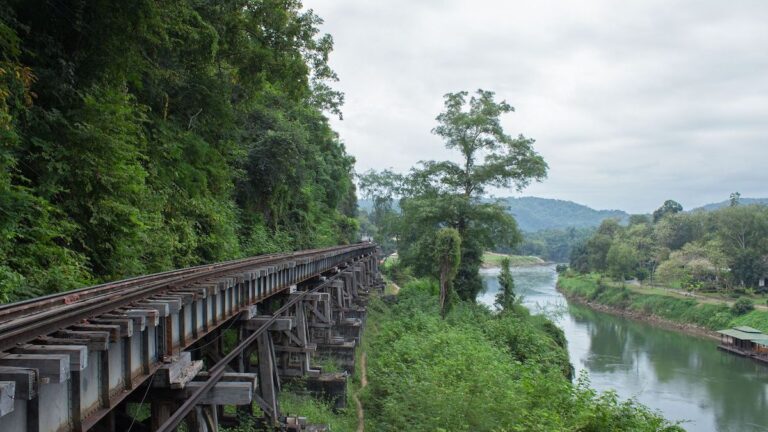Things to Do in Kanchanaburi
Notorious for its Bridge over the River Kwai, Kanchanaburi is an enthralling historical hotspot sitting 200 km east of Bangkok. Steeped in WWII-infused tales, the town is well known for the Death Railway. Built by the hands of the Japanese Imperial Army, the veil of humanity was stripped bare at a mind-numbing cost to over 100,000 POWs and innocent laborers. Delve into the history of this wartime saga, exploring heartrending memorial cemeteries and remarkably poignant museums.
 The river itself is still spanned by the bridge that was at the center of the 1950s Hollywood blockbuster that put this region on the map. Today it is peacefully lined with plush resorts interrupted by weekend disco barges that attract Thais from Bangkok. Kanchanaburi is also popular with the backpacker crowd and presents a soft adventure in the form of trekking and day trips to the fantastic national parks and waterfalls that rate as some of Thailand’s best.
The river itself is still spanned by the bridge that was at the center of the 1950s Hollywood blockbuster that put this region on the map. Today it is peacefully lined with plush resorts interrupted by weekend disco barges that attract Thais from Bangkok. Kanchanaburi is also popular with the backpacker crowd and presents a soft adventure in the form of trekking and day trips to the fantastic national parks and waterfalls that rate as some of Thailand’s best.
Kanchanaburi Attractions
A good starting point is the Kanchanaburi Allied War Cemetery, located in the northern section of the town, near most of the backpacker guesthouses. Adjacent to this neatly maintained memorial is the excellent Death Railway Museum which tells the full story of the suffering involved in completing this 416 km railroad through to Burma. Farther north is the original River Kwai Bridge itself, while several cemeteries are dotted about the area.
The most impressionable site however is Hellfire Pass and its exhaustive information center. If you’re not particularly interested in history, the Sai Yok and Erawan Falls are two lovely natural spots with national parks an hour’s drive west. Closer to the city is the popular Tiger Temple which raises big cats, and Wat Tham Mangkon Thong (Cave Temple of the Golden Dragon) which has a labyrinthine cave passage.
Kanchanaburi has a well-established tourist infrastructure and is mostly visited by tour groups who are bussed about the various sites along the Death Railway, as well as the varied natural attractions amidst the undulating and lush landscape of the Burma border. Numerous riverside guesthouses and lodges, together with an uncrowded atmosphere, make Kanchanaburi a good short tourist trip from Bangkok.
The biggest draw card in Kanchanaburi is the unavoidable history lesson from the Death Railway. The tragic story of the 416 km railway through to Burma, which cost more than 100,000 lost lives under forced labor by the Japanese Imperial Army, is recounted in several museums, cemeteries, and information centers in the area.
There are also some fantastic waterfalls and national parks, several intriguing caves, and numerous soft adventure activities that attract both free-spirited backpackers and tour buses alike.
Find out how to get from Chumphon to Kanchanaburi.
The Bridge over the River Kwai
The ‘bridge’ attracts tourists by the busload, especially in the late afternoon after they have all done the obligatory short rail journey. Much of the steel girders used are the original spans of the famous bridge that became the focus of the 1957 Hollywood movie of the same name. Although bombed in the closing stages of the war, it was rebuilt and continues to help dozens of trains and hundreds of tourists across the river. Open: always.
The River Kwai
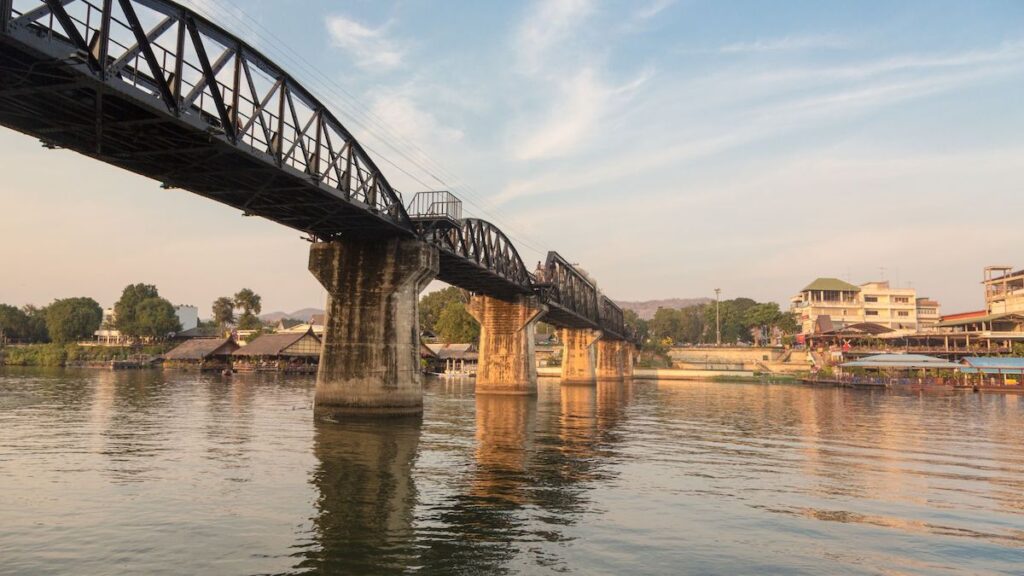 This is more of a focal point for the area than a tourist attraction, and it’s impossible to visit Kanchanaburi without experiencing this lovely river.
This is more of a focal point for the area than a tourist attraction, and it’s impossible to visit Kanchanaburi without experiencing this lovely river.
It consists of two tributaries, the Mae Naam Kwai Noi and Mae Naam Kwai Yai, which snake their way through lush typically tropical scenery with a rugged hilly backdrop. Many guesthouses and resorts front the river, but a lunch cruise is the best way to see it.
War Cemeteries
Several of these somber reminders of the Second World War are dotted about the area and can be reached by bicycle, taxi, or on foot. Scores of neatly arranged memorial plaques commemorate the estimated 12,000 British, Australian, Dutch, and American POWs who perished from disease, exhaustion, beatings, and injury during the construction of the railway.
The Allied War Cemetery in the town center is the easiest to visit, but the Chung Kai Cemetery, a little out of town, is more peaceful. The Chinese Cemetery, adjacent to the Allied War Cemetery, is not associated with the war but is interesting for its bizarre tombstones. The rotunda-shaped Regina Mundi Memorial is another landmark opposite the cemetery. Open: always.
Thailand-Burma Railway Museum
Informative multimedia displays recount the background, events, conditions, and tragedies of Kanchanaburi’s best-known legacy. Open: 09:00-17:00 (daily); tel: (034) 512 721.
Hellfire Pass
 This is the most impressionable reminder of the near-impossible task that was undertaken under pressure from the Japanese to complete their supply line to Rangoon.
This is the most impressionable reminder of the near-impossible task that was undertaken under pressure from the Japanese to complete their supply line to Rangoon.
A brilliant information center and free MP3 commentary have been provided by the Thai-Australian Chamber of Commerce, and it recounts every detail of the prisoner and laborers’ ordeal in a dramatic fashion.
It is a 45-minute drive west of the town along the railway and best reached on a tour. Open 09:00-16:00 (daily).
Wat Tham Suea (Tiger Cave Temple)
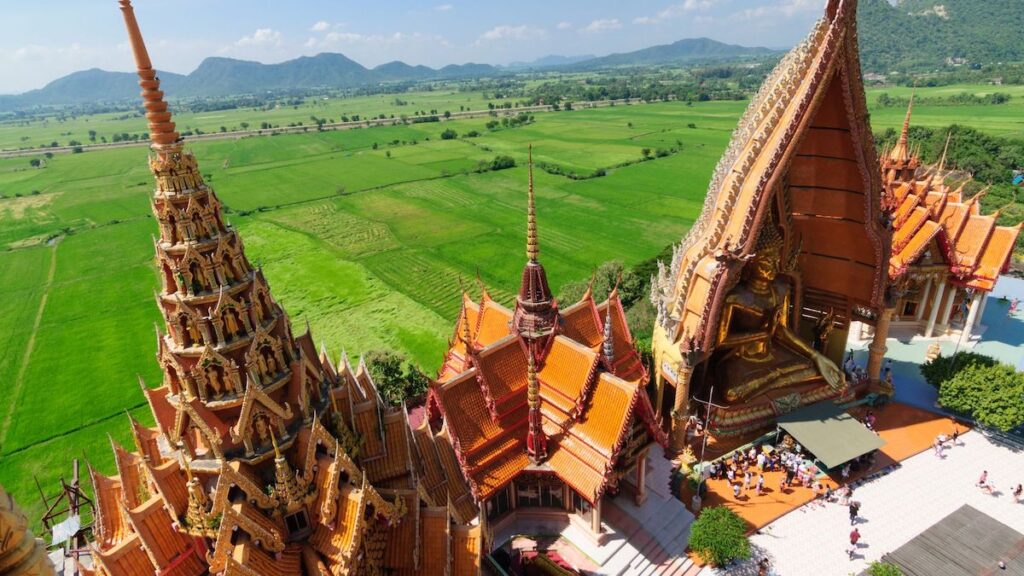 This more enduring temple, with a richer vein of history and importance than Wat Tham Khao Noi, offers hilltop monasteries around 15 km southeast of Kanchanaburi, with a particularly colorful Chinese character. The monasteries are built around a honeycomb of caves and include a short, exhausting climb, but offer some of the best views of the river. Open: always.
This more enduring temple, with a richer vein of history and importance than Wat Tham Khao Noi, offers hilltop monasteries around 15 km southeast of Kanchanaburi, with a particularly colorful Chinese character. The monasteries are built around a honeycomb of caves and include a short, exhausting climb, but offer some of the best views of the river. Open: always.
Traveling from Bangkok? Check out how to get from Bangkok to Kanchanaburi.
Prasat Meuang Singh Historical Park
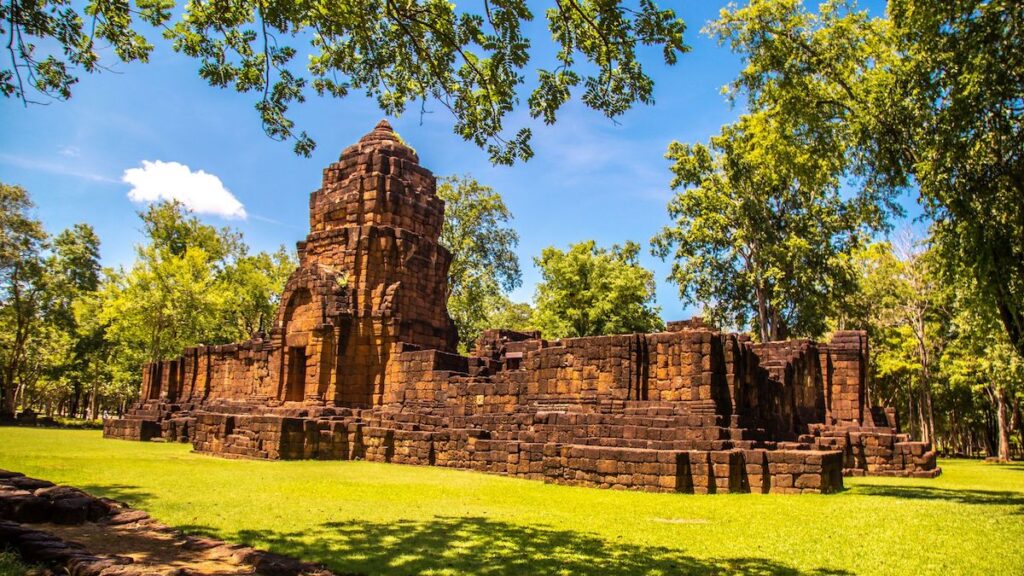 Kanchanaburi’s very own ancient ruins are found 40 km west of the city and include original Khmer remains from a 13th-century outpost of the Angkor empire. A sizeable compound of laterite walls and ramparts remain, including some Khmer prangs and further sites yet to be excavated. Several significant shrines remain and a museum on the site retraces the pre-Angkor civilizations that lived here. Open 09:00-18:00 (daily).
Kanchanaburi’s very own ancient ruins are found 40 km west of the city and include original Khmer remains from a 13th-century outpost of the Angkor empire. A sizeable compound of laterite walls and ramparts remain, including some Khmer prangs and further sites yet to be excavated. Several significant shrines remain and a museum on the site retraces the pre-Angkor civilizations that lived here. Open 09:00-18:00 (daily).
Wat Nuea Pagoda
This unusual Chinese-style pagoda defies the usual chedi-shaped Buddhist icons seen all around Thailand and is a rather colorful and new multi-story structure beside the river with distinctive Chinese Buddhist religious importance. Open: always, admission: free.
Kanchanaburi Museums
There are two other museums in Kanchanaburi capitalizing on the Second World War; the rather dated and unremarkable JEATH Museum is downtown next to Wat Chai Chumpon and hardly worth the trek. The WWII Museum next to the bridge is a poor attempt that is more fixated on the Chinese heritage of its owners. Open 09:00-18:00 (daily).
Activities in Kanchanaburi
Riding the Death Railway
This is one of those cheesy ‘must-do’ activities which is included on every tour itinerary in Kanchanaburi. Usually, tours end up at Kra Sae cutting late in the day, which has an unremarkable cave to explore while you wait for the train. Most of the original railway is no longer in use, but this particular section crosses original wooden trusses alongside the river and cliffside in a pretty setting.
Jungle Trekking and Rafting
The chief attraction for those too young to be bothered with history, Kanchanaburi is a great place to experience the Asian jungle. Numerous tour operators can arrange single or multi-day treks to hill-tribe villages, which include skiff rafting. The hilly scenery of the area adds to the impression.
Caving
If you’re interested in caving, you’ll find the labyrinth of narrow passages at Wat Tham Mangkon fun. Unlike other caves in Thailand, this one seems tailor-made with a maze of meandering passages that send you around in circles. It’s the best of several caves in the area including those at Kra Sae and Wat Tham Seua. It’s also within cycling distance of the town.
Visiting Waterfalls and Parks
 You cannot go from Kanchanaburi back to Bangkok without witnessing the lovely cascades of Sai Yok and Erawan waterfalls, which each have their own commendable national parks full of hiking trails and picnic spots. You’ll need a full day to visit both (on different highways west of the town) and Sai Yok dries up between January and May. Along with the less accessible Huay Kamin Falls, they are among the prettiest and most impressive in Thailand.
You cannot go from Kanchanaburi back to Bangkok without witnessing the lovely cascades of Sai Yok and Erawan waterfalls, which each have their own commendable national parks full of hiking trails and picnic spots. You’ll need a full day to visit both (on different highways west of the town) and Sai Yok dries up between January and May. Along with the less accessible Huay Kamin Falls, they are among the prettiest and most impressive in Thailand.
River Cruising
A great way to while away a balmy tropical afternoon is to club together with others and rent a barge (around 2,000 baht for three hours) for a booze cruise down the River Kwai, with lunch provided. The scenery is lovely and the water is swimmable. Alternatively, join the locals on one of the noisy evening-time floating discos that take off from near the JEATH Museum.
Excursion to Three Pagodas Pass
With a little more free time, consider an overnight trip to the Three Pagodas Pass on the Myanmar border. There’s nothing particularly memorable about the three pagodas, but the 200 km drive here with an overnight stay in the lakeside town of Sangklaburi is very scenic.

